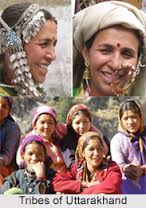The tribal population of Uttarakhand is concentrated in the remote and forest areas of Tarai and Bhabar and high reaches of Pithoragarh, Chamoli, Uttarkashi districts and Jaunsar-Bhabar area of Dehradun district. Some are of Mongoloid origin and have a nomadic or semi- nomadic way of life. However, now – a – days, most of these people have taken to a settled life and are engaged in animal husbandry, agriculture, trade and other occupations . The total population of Uttarakhand in 2011 Census has been 10,086292. Of these, 291,903 persons are Scheduled Tribes which constitutes about 3 per cent of the total population of the state. The state has registered 14 per cent decadal growth of scheduled tribe population in 2001-2011. There are total of five notified scheduled tribes in the state, and all of them have been enumerated in 2001 Census. These are:
- Tharu (Udham Singh Nagar, Nainital, Pauri and Dehradun.) 2. Jaunsari (Dehradun, Uttarkashi and Tehri.) 3. Buksa (Dehradun, Nainital, Udham Singh Nagar, Pauri and Hardwar.) 4. Bhotia (Almora, Chamoli, Pithoragarh, Bageshwar and Uttarkashi ) 5. Raji (Pithoragarh and Champawat)
Tharu
The Tharus is the largest scheduled tribal community of Uttarakhand. Their language seems to be highly influenced by Hindi and Nepali. Traditionally, they used to practice ‘badla’ marriage in which two men marry each other’s sisters. The tradition of joint family is still very strong among the Tharus. The religious beliefs and the pantheon of the Tharus resemble those of the neighboring Hindus. They also believe in witchcraft and sorcery and offer sacrifices to all their deitie. Among their major festivals are Dussehra, Diwali, Kanhayya Astami and ‘Bajhar’. Tharus are basically an agriculturist tribal community. However, they also are experts in fishing.
Jaunsaris
Jaunsaris are a Central Himalaya tribe. Jaunsaris claim themselves as the descendents of Pandava of Mahabharat. They inhibit Jaunsar-Bawar (Upper Dehra Dun district) and Rawain (present day Uttarkashi) are distinct from their Garhwali neighbours in their style of dress and unique cultural practices in Uttarakhand and Purola region of Uttar Pradesh. As a collection of smaller tribes, Jaunsari society is caste stratified with the indigenous Koltas as the main service caste and Khasa Brahmins and Rajputs as the main cultivators.
The Jaunsaris are well known to be one of the few polyandrous societies in the world, although this practice is receding into history. Marriage and sexual mores also tend to be more liberal, with women enjoying greater freedom to choose and divorce. Jaunsaris are also famous for their colorful clothes and festivals . Jaunsaris are known to be Hindu and worship Hindu Gods along with their own God, the principal one being Mahasu .
The socio-cultural practices of the second most populated tribal community, the Jaunsaris, is truly reflective of the kaleidoscopic heritage of the region, the Jaunsar-Bawur. The strongest of community led social practice and customary management, the Khat, has not only no parallel in the entire Uttarakhand, but has survived the evolution of a so-called modern panchayati raj.
Buksa
Buksa are the residents of the Terai district of Uttarakhand and they assert their lineage from the Rajputs. The culture of the Buksa reflects a typical Hindu society but they also accept the existence of nature spirits and eat meat. They are spread over 173 villages of mainly Nainital and Dehradun districts. However, the main concentration of the Buksa tribe is found in Gadarpur, Ramnagar, Bajpur and Kashipur regions.
Bhotias
Bhotias, a Mongoloid ethnic community, traditionally lived in the high Himalayan region, close to the Tibetan border. The term Bhotia comes from “Bo” which is the native Tibetan word for Tibet. In the winter, they migrate to southern climate, although recently, many have begun settling permanently in the mid-Himalayas.
Bhotias are subdivided into three main categories: The Jadhs of Uttarkashi, the Marchas (once mainly traders) and Tolchas (farmers) of Chamoli, and the Shaukas of Pithoragarh (near Dharchula). They are generally involved in the developement of best quality wool.
Rajis
The Rajis is a socially and economically the most underdeveloped tribal community of Uttarakhand.
They are also described as Van – Rawat (King of forest), Van- Raji (Royal people of forest) or Van – Manush (Wild man or man of forest).
They claim themselves to be Rajputs and the original inhabitants of Central Himalaya, though anthropologically they belong to Tibeto Burman family and until recently they were a community of nomadic hunters and gatherers.
The Raji have a strong liking for alcohol. They like wild fruits and tree roots. The Raji women wear large and heavy jewelry that is admired. Not many of the Raji dress in the usual tribal way. They are artistic. Good looking handbags are made that are sold in the markets and in the rest of India. Most of the Raji live in the interior forest regions. They work as
gatherers. They collect honey from bee hives. They work in agriculture and other occupations. They grow cereals and they fish and hunt. They make tools for agriculture. Women have a good position amongst the Raji. The Raji do not marry each other and there are no child marriages. The oldest man is the leader of the family. They speak with each other in the Raji language. They are Hindus in religion and worship the Hindu gods Bhagvati and Nanda Devi.
